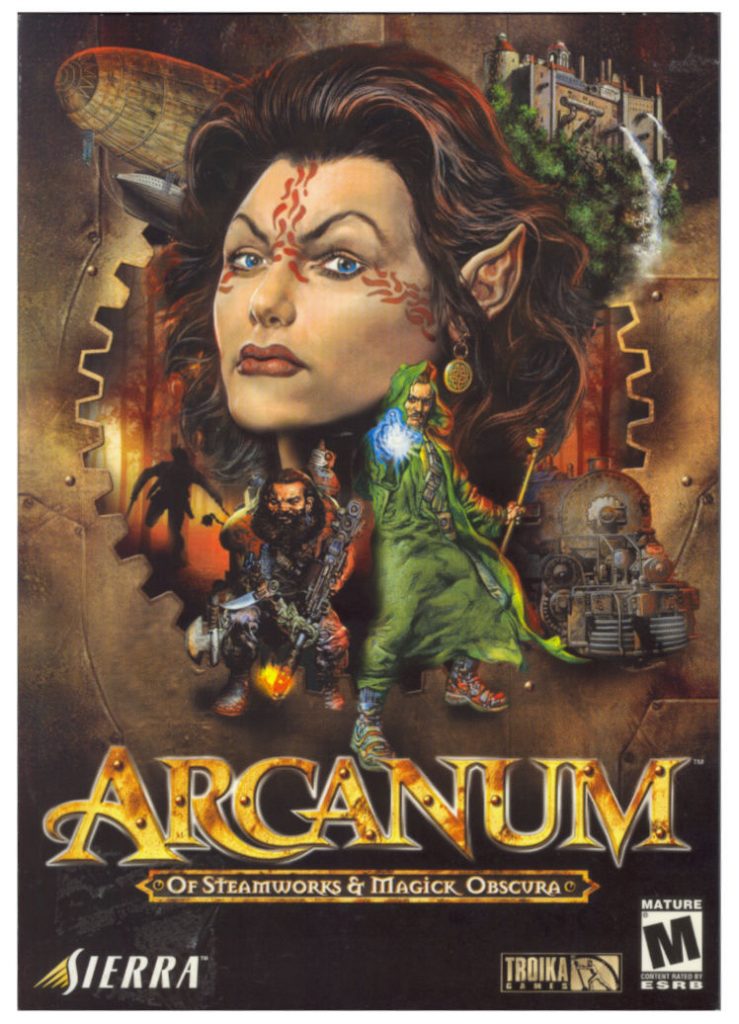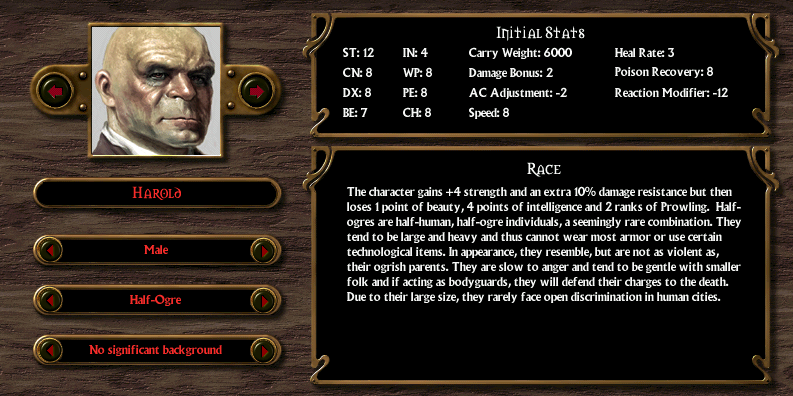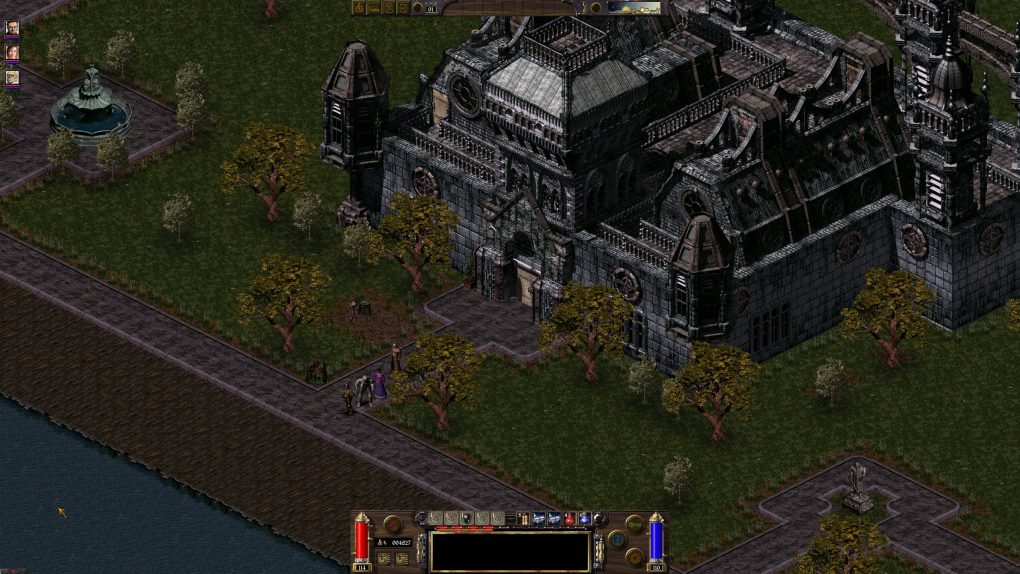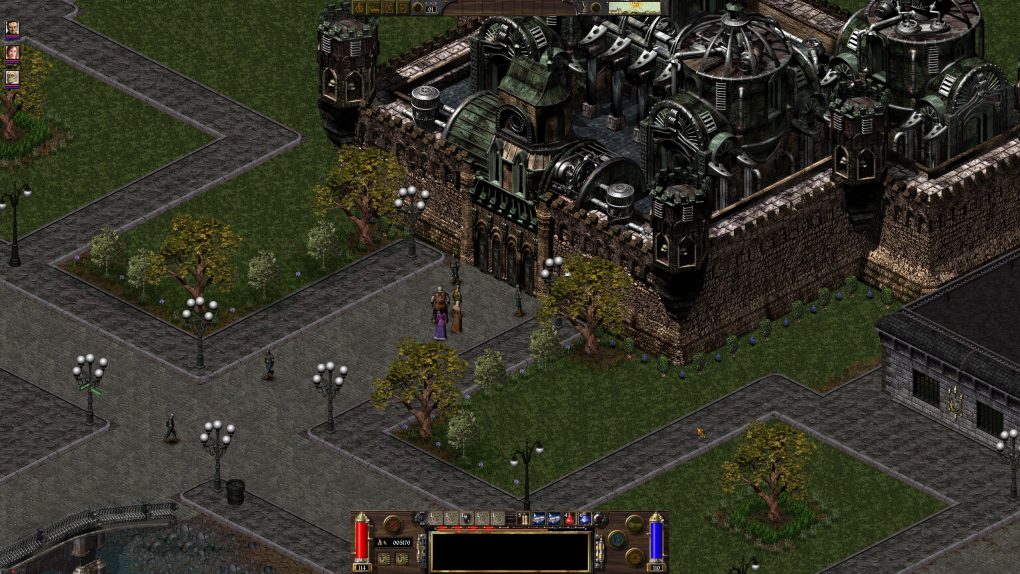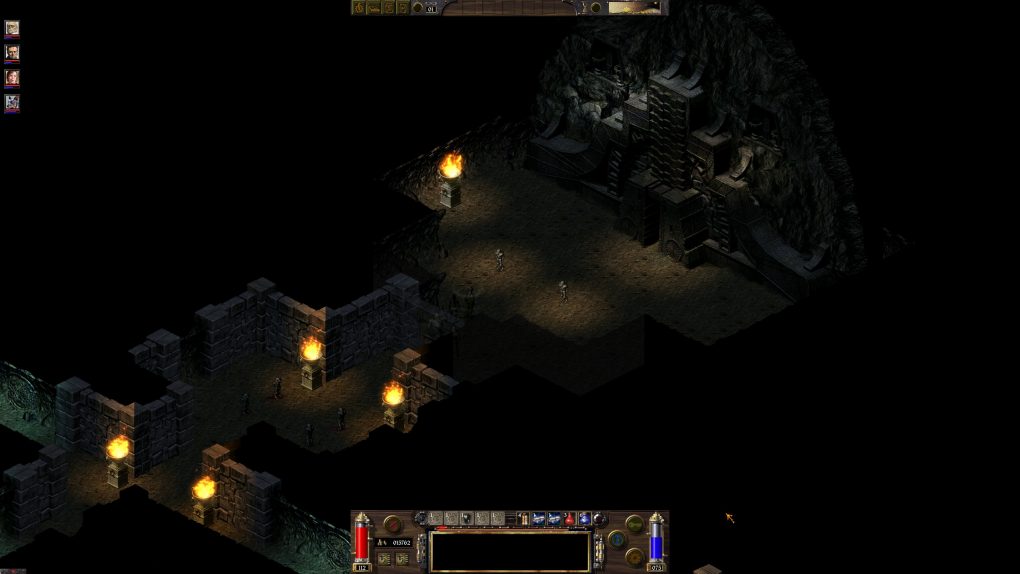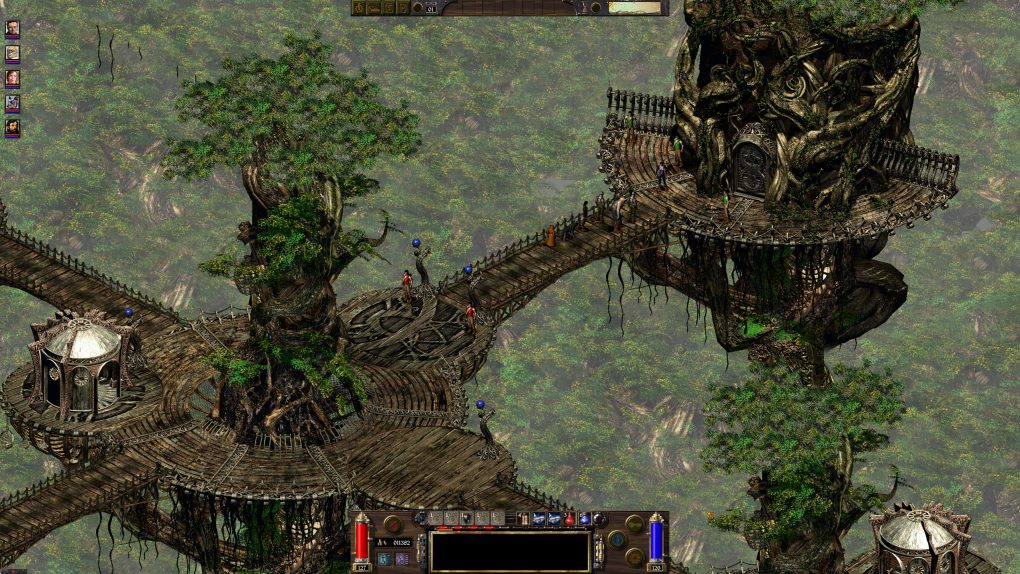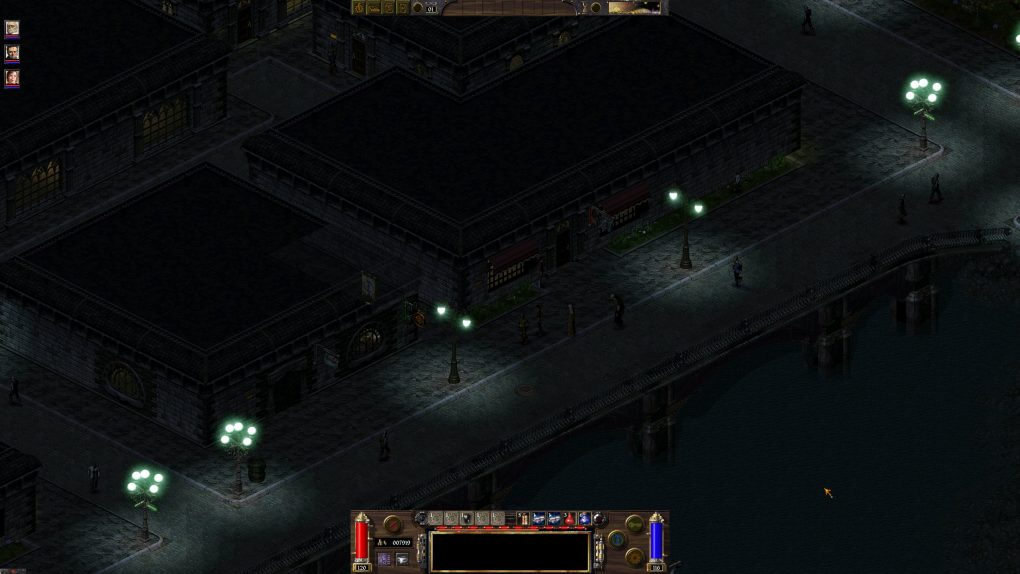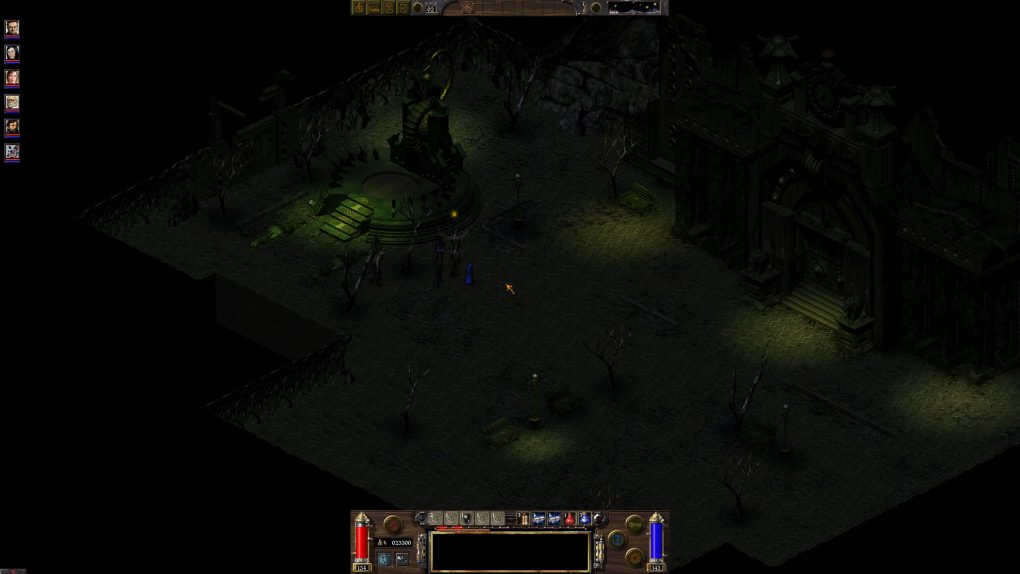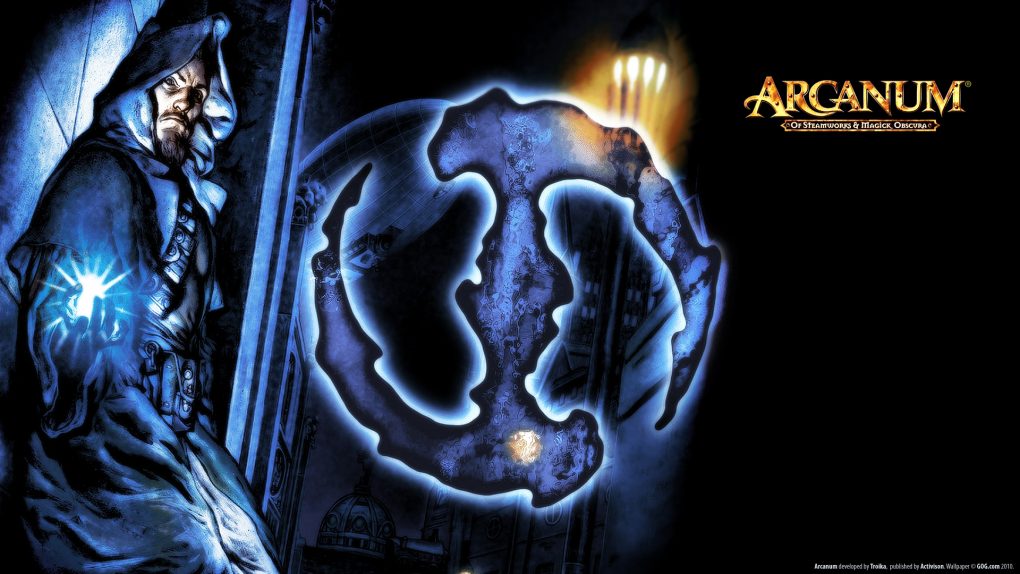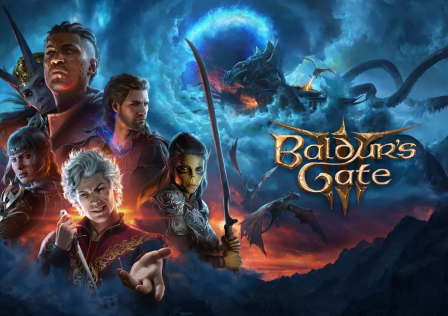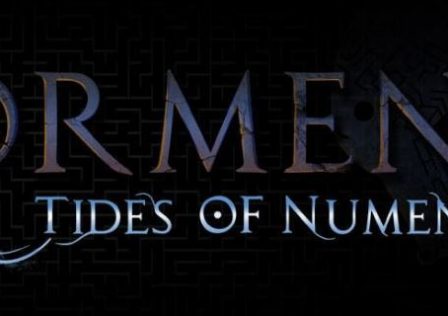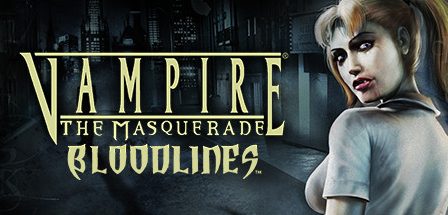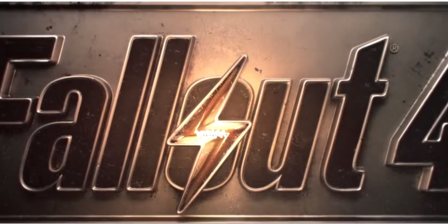In any discussion about the greatest video game RPGs of all time, Arcanum: Of Steamworks and Magick Obscura is bound to be mentioned, and rightfully so. Arcanum is a steampunk fantasy RPG released by Troika Games in 2001, making it perhaps the best debut for any video game studio. It is one of two tier 2 occupants on our video game RPG tier list, meaning only one video game RPG has more role-playing than it (that being Fallout 2). Troika Games was formed by ex-Interplay employees, so much of Fallout’s brilliance is on display throughout Arcanum.
Arcanum is an isometric 2.5D game that lets you choose between real-time combat and turn-based combat. Off hand I cannot think of another RPG that gives you such an option. Its superior quality and 190 page manual might make the educated RPG fan think it comes from a pen and paper RPG, but it does not. It is an original video game RPG, one of the best of all time in this regard again not unlike Fallout and most of all Fallout 2.
It is set in the world of Arcanum which consists of a massive continent and several off shore islands. It is almost completely open world with only a few locations not being accessible until you advance to a certain point. The world of Arcanum resembles a parallel 1800s United Kingdom in which magick exists but is being replaced by steam based technology, making for a very unique setting and intriguing conflict. It plays off of its setting well as we will soon discuss, taking advantage of the literary intrigue it presents in the form of story and quests, and also taking advantage of the setting in the form of gameplay diversity.
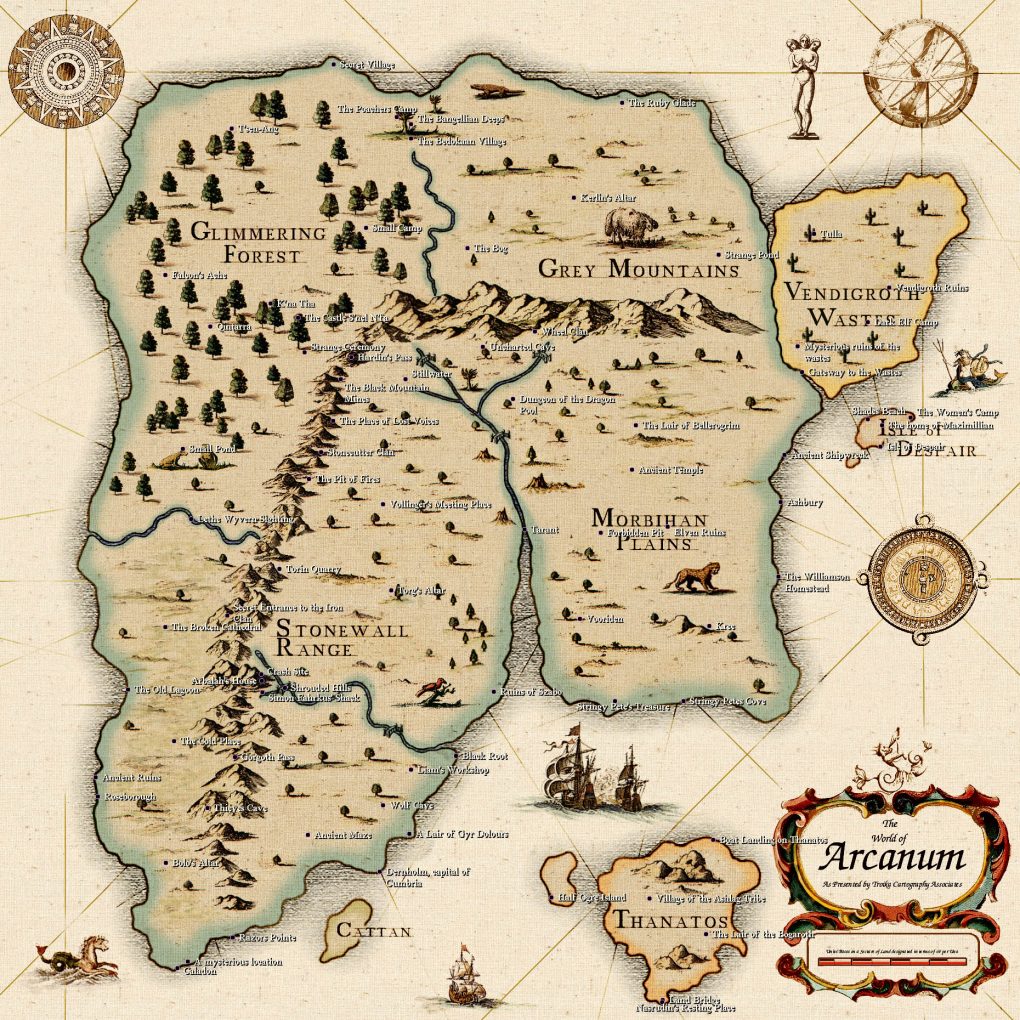
The massive world of Arcanum has very few loading screens, and only select few small locations require advancing to certain parts in the plot before they can be accessed.
Arcanum is available on both GOG and Steam, and only supports Windows. It needs some work before it can run at widescreen resolutions. Don’t be intimidated, all that’s needed is one unofficial patch. In Windows Vista and newer, it is also necessary to run it as administrator and use the following compatibility settings: Disable Display Scaling on High DPI Settings, Disable Desktop Composition, and Disable Visual Themes.
After these tweaks it may or may not run with no severe issues… if it doesn’t, then try disabling fullscreen mode which should work, and if not then try lowering the resolution and also try different GPU drivers.
Even with these tweaks it will not be perfect. But remember, it works with Borderless Gaming. These days I play Arcanum in 3840 x 2160 120 Hz borderless windowed.
Gameplay
Reading the 190 page manual, which is included with the GOG version in PDF format, is a good way to get acquainted both with the world of Arcanum and the gameplay mechanics. It goes into everything in perfect detail. No, not all 190 pages must be read, much of that goes over installation and options configuration which you can do yourself.
Let’s review Arcanum’s gameplay in the order the player experiences it, starting with the character creator. Character generation is only done in two parts: part 1 is where you select your race, gender, name, and background, and part 2 is where you adjust your stats and skills. There are dozens of backgrounds which mostly adjust your statistics but can affect dialogue as well, and the following races are available:
- Human
- Dwarf
- Elf
- Half-Elf
- Halfling
- Gnome
- Half-Orc
- Half-Ogre
Race has massive impact on statistics, dialogue, and quest availability. The only game that can compare in this regard is Troika’s own Vampire: The Masquerade – Bloodlines. You will encounter racism and also favoritism, and unlike a modern RPG this won’t just affect brief in-the-moment dialogue, it will follow you everywhere you go, completely alter quest availability at times, and much more.
The second part of the character creator lets you allocate points into eight ability scores (aka attributes) and numerous skills. Your value in these eight ability scores can and will completely change dialogue at times, with intelligence being able to alter 100% of the game’s encounters and your dialogue choices, and charisma coming close to that. Yes, that means Arcanum lets you play as a mentally deficient “dumb” character who can barely speak like in Fallout 2, but on the opposite side of the spectrum Arcanum is more responsive to high intelligence than Fallout 2, which is very nice to see in a game like this that lets you become a technological genius or master of the arcane arts.
All of these skills and also your hit points (health) and fatigue values are affected by your ability scores.
The skills of Arcanum are listed below:
Combat Skills
- Bow
- Dodge
- Melee
- Throwing
Thieving Skills
- Backstab
- Pick Pocket
- Prowling
- Spot Trap
Social Skills
- Gambling
- Haggle
- Heal
- Persuasion
Technological Skills
- Repair
- Firearms
- Pick Locks
- Disarm Traps
Continuing with the most recent screenshot above, the two buttons next to the skills button will reveal technological disciplines and spells from left to right, and all the way at the right we see the tech/magick gauge. Technology and magick conflict with each other in the world of Arcanum, so players are advised to go one way or the other… or neither. A “do it all” type character will always result in failure. This makes sense, and it ties into the plot. Technology is science, magick contradicts it, changing the laws of physics in real-time which can break technology.
The technological disciplines each contain seven degrees, each one representing your level of expertise. These degrees are: Novice, Assistant, Associate, Technician, Engineer, Professor, Doctorate. The eight technological disciplines of Arcanum are:
- Chemistry
- Electric
- Explosives
- Gun Smithy
- Herbology
- Mechanical
- Smithy
- Therapeutics
What are these disciplines for, you ask? Use common sense, apply real world logic. This is how you have to think about real RPGs like Arcanum and pen and paper RPGs, after all they are essentially life simulations. This thought process is foreign to console gamers and gamers who only play modern RPGs which are highly illogical.
So to answer this question, your skill level in technological disciplines is the most significant factor in determining technological combat abilities and recipes; each degree unlocks a new recipe, so crafting is more important in Arcanum than perhaps any RPG. Much of the best gear must be crafted, but thankfully crafting is not grindey at all and supplies are common in stores. Degrees are also significant on role-playing; specific expertise levels in specific disciplines will open up new quest options and quest availability, they will affect dialogue, and the more you delve into technology the more your tech/magick gauge shifts toward tech.
This tech/magick gauge is one of the most important role-playing attributes, right up there with reputation (which is based on your actions, just like in Fallout), race, intelligence, and charisma. How technologically or magically adept you are has tremendous impact on dialogue, quest availability, trading potential. Magick shops for example will deny you immediately if you are a technological expert, since again you have to keep in mind that technology and magick are in opposition of one another on a fundamental level as tech draws on earthly rules (sciences) while magick disrupts these. NPCs strongly in favor of one or the other will not want to talk or be nice to you, and if you are trying to seek quest-related information from them which you undoubtedly will be doing, it makes for a very interesting and responsive RPG like none we see today, objectively speaking.
All of these role-playing features I describe apply to magick too. Technology has disciplines and degrees, while magick has spell colleges. The spell colleges (or types of magick) in Arcanum are as follows:
- Conveyence
- Divination
- Air
- Earth
- Fire
- Water
- Force
- Mental
- Meta
- Morph
- Nature
- Black Necromantic
- White Necromantic
- Phantasm
- Summoning
- Temporal
Sixteen types of magick, which blows away most other games, especially modern RPGs which lack important fundamentals like healing (White Necromantic), typical Necromancy (Black Necromantic), Summoning and Morph.
Arcanum has five spells in each of these colleges, for a total of 80 spells. Not an overwhelming amount, so any magick focused player isn’t going to be focusing on only one spell college. You can, but it’d get tiring using only the same five spells the entire game. This is something that separates Arcanum from later released D&D games, namely The Temple of Elemental Evil by the same studio and also the Neverwinter Nights series which provide enough spells in each of their magic schools to focus on just one the entire game if you choose to.
The same applies to Arcanum’s technological disciplines; with 7 degrees in each, chances are you will focus on more than one. On the bright side, this means you’re going to see superior diversity either way, but on the downside it means specialist type playthroughs are less exciting.
There are some oversights in Arcanum’s magic though. The level 1 Black Necromantic spell, Harm, is overpowered. It damages literally everything pretty much the same amount, making it a universal tool. Logically, should not work against undead or constructs (including robots). Quench Life, the level 5 Black Necromantic spell, becomes underpowered due to Harm, since casting Harm multiple times is often more efficient than using Quench Life. To compensate, not only should Harm not work on non-living creatures (and neither should Quench Life; if there’s no life then there’s nothing to quench), but Quench Life should heal the player for the amount of damage it caused. Boom, better balance.
What the hell is with early 2000s RPGs and spells called “Harm” being overpowered? You see it here as well as in two 2002 RPGs, Arx Fatalis and Neverwinter Nights. Though at least in Neverwinter Nights it doesn’t make any other spell obsolete and you won’t spend most of the game using it if you’re a caster who can use it, so it’s a very minor issue there, but not so much in Arcanum nor Arx Fatalis.
But getting back on track, you are able to unlock both technological degrees and spells as you level up, but they each have prerequisites including a level prerequisite, as well as requiring the degree or spell beneath them, as expected—it wouldn’t make much sense to achieve a doctorate without first getting an associate and all the others.
As with many classic RPGs, Arcanum has more diverse spells and more powerful high tier spells compared to today’s RPGs which are afraid to be ambitious, exciting, they’re simply afraid to be good, as they limit themselves to the same generic dumbed down content in all categories. That isn’t to say balance is worse in Arcanum than today’s RPGs, it is much better usually, as it adheres strongly to logic (so a sword/shield fighter is going to be a lot more limited at higher levels than a tech expert wielding explosives and guns and crazy gadgets and also weaker than an elite mage) and there are significant benefits and downsides to both tech experts and elite mages, depending on the enemies you are fighting. There is no clear cut best play style in Arcanum, beyond doctorate level tech and top tier mage both being the most powerful builds, and considering there are eight technological disciplines and sixteen spell colleges, that leaves room for tons of variety.
High level technological degrees let you make some amazing gadgets, from weapons to protection and useful tools. From chemical weapons that paralyze or cause hallucinations or work as anesthetics, to healing jackets (yes this is technological, not magical) and shocking staves and tesla rods, to devices that detect traps easily, to stun grenades and dynamite (explosives can destroy doors and other physics objects, letting you bypass locked doors and such to finish quests before you’d expect to), to powerful drugs of all kinds, incredible guns like the Hand Cannon and Elephant Gun, to making auto skeleton keys and mechanical decoys and mechanized arachnids, and much more, Arcanum has incredible recipes leading to mind blowing devices to be used in gameplay, both in and out of combat. Some of the most creative inventions and equipment you will ever see in any game! Modern tamed RPGs don’t come close with their limitations to generic elemental spells and common bladed (and blunt, if lucky) weaponry.
It is so satisfying to be an electrician, a bomb maker, a chemist, really anything Arcanum offers. It has a fantastic selection of all kinds of equipment too, so regular fighters and rogues are not left in the dust. It does every playstyle justice. The only comparable RPG is Underrail which also lets you use technology, melee, guns, inventions, magic.
And let’s not forget that Arcanum can be played both in real-time or turn-based, by selecting one of these in the options menu. Name another game with this option, I’m waiting (2020 edit: Pathfinder: Kingmaker now has it as an update, and Pathfinder: Wrath of the Righteous will also have it). Turn-based is easier since real-time is… fast, and combined with the distant isometric 2.5D perspective (modern isometric 2.5D RPGs, which should not exist, are zoomed in more), it is not recommended. Hardcore players like it for the challenge, but the truth of the matter is real-time is meant for 3D RPGs. Still, the option is nice and hurts nobody.
Arcanum thankfully has a fast travel, which lets you travel anywhere you want unless it would require crossing a bridge or taking a ship. I say thankfully, since Arcanum is the size of a damn country so it doesn’t use all of its space. This means Arcanum is not one of the very few open world games that really makes use of all of its space well, but it does a pretty good job at least. Quests obviously take you all around, and Mazzerin’s Mystery is a clever way to make use of its gigantic open world. But nevertheless, you can’t get around the fact that the majority of the world space is unused.
For travelling to areas that require crossing a bridge, you need to locate the bridge first and travel over it yourself, before you can fast travel across these areas. Such limitations are rare in the game world. By default, hardly any locations are marked, so you can easily fast travel blindly, something most modern games don’t let you do.
So with all of this, we have provided a ten thousand foot view of the gameplay of Arcanum, so to speak. There is no need to rest, eat, or hydrate yourself in this game, but you do have to maintain equipment condition. Arcanum’s gameplay strengths are its volume of content, diversity of content from equipment to spells to creatures, and also its incredibly creative gadgets which usually have to be crafted from recipes you unlock by leveling up. Then there is the role-playing, which defeats all but one video game (at least when considering single player only), and the quest design which we will go over more later. The core rule/stat system of Arcanum is excellent; very logical and robust, one of the very best free form leveling systems there is, with only a few setbacks. It is so good that it seems as if it originated from a pen and paper RPG, but it didn’t.
Arcanum’s weaknesses are small oversights in the functionality of some of the spells (coding oversights or errors), some balancing issues with Black Necromantic spells and mind spells (both of these must not affect nonliving creatures, but unfortunately they do) and the AI could use better tactics. Though it is nice that AI will turn tail and flee when losing badly, something more games need.
Story
Arcanum: Of Steamworks and Magick Obscura is one of few games that excels in both gameplay and writing. Fallout and Fallout 2 role-playing, writing and quest design far outshine their mechanics, same for Planescape: Torment. Most RPGs today are incredibly weak in both.
Arcanum objectively has significantly more depth and originality than nearly every post-2010 RPG in the following areas: world building (more world elements and lore while modern games leave out so many important elements whether it’s religion or explaining their governments and city/town histories and technology and magic, more exposition, actual writing style), themes, and dialogue. Character development isn’t as strong, but what’s there is great; the conversations you have with key NPCs such as Gilbert Bates, Loghaire Thunderstone, and others portray them as authentic, genuine, believable characters with distinct motivations, but you never have more than one big conversation with most of these characters. That one big conversation is great, but RPGs like Planescape: Torment will give you more than just that for its characters.
But the world building is exceptional. Make sure you read books in the world, they’re actually particularly well written unlike in Skyrim and other AAA games today. Books that provide insight into different places, religions, cultures in the world of Arcanum, and also newspapers in Tarant which give you interesting current events, some of which you can even follow up on yourself. Arcanum uses everything to its advantage. There is more thematic depth and originality just in the books throughout Arcanum than the entirety of most other games. Books like “The Orcish Question” volumes 1 and 2, other philosophical musings, all of the autobiographies in the game, and of course “Horror Among the Dark Elves” which we’ll talk about soon.
The closest I’ve seen to this level of writing in 2010s RPGs are Fallout: New Vegas and Disco Elysium. The former excels in character development more than Arcanum but isn’t as thematically rich. Disco Elysium is as thematically rich and goes a bit farther with character development but still falls shy of excellent there, and its writing style is a bit too plain for it’s own good.
Also, Arcanum really does have a weak ending. Troika Games built up such an epic universe and story along the way, but then the game was rushed to completion (as were their other two games) and they failed to find an adequate conclusion to it as a result. To this day, I will always wonder what a good ending would be like. I do have my own ending in mind, but it would have taken more time to develop. More on this below.
As with many games from this time period, players are encouraged to read the manual (which is an astounding 190 pages long). It contains lots of world building and lore in its own right. The world of Arcanum is a sort of parallel fantasy version of 1800s United Kingdom, so the industrial revolution in the game is not unlike the one we actually saw, though more advanced as the intro demonstrates.
The only question/problem is, why didn’t the gnome tell us the name of this boy?
You play as someone either in the wrong place at the wrong time, or in the right place at the right time. That will forever be up to debate. The lone survivor in an airship crash, which conveniently puts you in the position to being dubbed the Living One—a prophet in the Panarii religion, the reincarnation of an ancient great elf. This may seem trite on paper, but the game approaches it in a way that isn’t. At first, it is rather comical about it: immediately after the crash, after the intro above, a character new to the Panarii religion approaches you, panics, and babbles in what can easily turn into a hilarious conversation.
So Arcanum will play with your expectations about whether or not your character is some typical RPG chosen hero. It is immediately apparent how many elements Arcanum has to write and deal with; a huge open world with many noteworthy locations, all of them need to be written. Governing bodies need writing, religions need writing, all of the races and conflicts between them, all of the technology and magick, and then the main story itself and the role-playing and characters. With a modern day RPG of a similar scale, like Dragon Age: Inquisition and Mass Effect: Andromeda, its lack of literary influence would lead to it not focusing heavily on any of these elements. But the more common trend would be to put a little bit more effort into character melodrama (this is NOT necessarily good character writing, and usually isn’t), as BioWare does.
But Arcanum? It is clearly written by much more talented writers who must have a background in writing, while most other games (including those from BioWare) are quite clearly written by people without any writing background and don’t even read as a hobby. As a result, Arcanum manages to succeed writing all of those elements. It doesn’t have strong focus on characters, but at least they aren’t irrational, unbelievable morons or cut-outs of the same character templates like most games and movies and TV shows. And more importantly, Arcanum does a much better job humanizing typical NPCs; they are actual people, often with distinct dialogue, rather than just useless bodies asking for help like in BioWare games. The characters of Arcanum serve their purpose with distinction that a character needs.
Large scale games today simply have no effort put into most or all of those areas of writing, but Arcanum brings it all into the discussion in a thoughtful and professional manner. It’s just so rare to see this, making Arcanum a real treat even more so today than back in 2001 when video game writing (and overall quality) held higher standards.
As expected, Arcanum’s story is one about industrial revolution and it explores the benefits and consequences of it from various perspectives, like the nature loving elves, the stout dwarves, and the short lived humans. It builds up a conflict about magick vs technology and the carelessness of humanity’s use of technology.
The same goes for its world building; it is a massive open world game, and every civilized location is uniquely written with its own lore and stories, a world where religion actually has a presence along with its controversies. Multiple religions of course, all explored either through optional character interaction, optional exploration, optional reading of religious texts, and quests.
The majority of Arcanum wonderfully discusses the industrial revolution themes, and how it’s short sighted and ruining the planet. Plenty of great arguments are presented from both sides in the form of NPC dialogue, books found in the world, and the quest design itself. These themes are backed into the main story, which revolves around an ancient conflict about magick vs technology; the governing body of Arcanum, the Elven council, had their power due to their unprecedented mastery over magick. Conflict arose when the most technologically advanced civilization in an underground city called Vendigroth aggressively pushed for technological advancement, going as far as creating a weapon specifically designed against mages. As a result, one of the Elven council members, Arronax, eradicated all life from that entire region. This spawned the Dark Elves, who believe in Arronax’s decision and that Elves should rule Arcanum once again.
Then you also have the Dwarves’ perspective; they are the most technologically advanced people, but they are not so careless with their use of technology since they are a long lived species so they actually live to see the consequences of their actions unlike humans. There is an obvious allegory here about humanity’s industrial revolution and how we’re speeding up the demise of our species with our carelessness. But are the Dark Elves going to far? Was Arronax right or wrong? It’s up to you to decide.
Throughout Arcanum you’ll also learn about Tarant, its equivalent of London, and its aggressive human and now technological expansion and how it obliterated the Kingdom of Cumbria for not accepting their industrial revolution. In-game, the capital of Cumbria, Dernholm, is a ruin. The history of Tarant is written in blood, so typical for human history, and it is not unlike the nation it resembles in Great Britain which is no coincidence.
NPCs are also written with greater attention to detail than most other games, and combined with its amount of role-playing (which is only surpassed by Fallout 2), and dialogue quality and authenticity, it makes for a plausible, believable, living world. It becomes so much more immersive than hollow RPGs from today for example.
So many of its quests (including optional side quests) serve to further expand upon the world as well as thematic elements of the story, delivering additional perspective and interesting characters to think about. The quests are also written far better than most other RPGs, especially modern ones which are ripe with fetch quests or “goose chase” type quests (e.g. find this person, then find that person, and each time said person is marked on your map, like in the disappointing Torment: Tides of Numenera).
For example, Arcanum literally incorporates an authentic Lovecraftian short story as a quest. This quest involves carrying out a detailed investigation into paranormal, creepy events. The investigation is an authentic one; it starts off by reading a nonfiction book written by someone who was investigating the matter at hand. Then it involves following up on leads mentioned in the book, which entails visiting a city’s public archives and inquiring about persons mentioned in said book, and more detective work along those lines. It is logical, diverse, and suspense continually elevates as you progress through the quest.
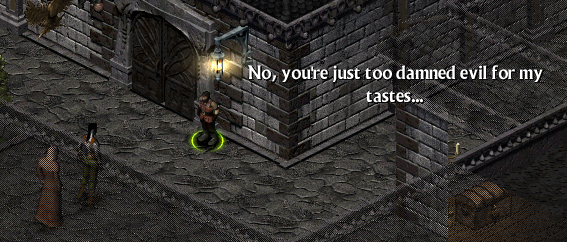
This is typical Troika Games greatness, evident in Vampire: The Masquerade – Bloodlines as well, but the quest design is usually even more open ended here with more ways to do them. Quests are unique stories in their own right, still connected to the main story of course, but they include their own unique themes, styles, tropes, cultural references, social commentary, and more. Dozens of quests like this appear in both games, it is a level of writing depth that you will not find outside of late 1990s and early 2000s RPGs (not at this scale that is).
Another noteworthy quest is the Half-Ogre Island side quest. Here, you can involve yourself in a conspiracy that starts off very secretive – a man asks you to deliver a message to another man, who then captures and threatens you because he’s well aware that the person who hired you was an assassin and you have no idea of this. This man, Sir Matt de Cesare, will then give you a quest to find the unique skulls of the Ren’ar siamese twins, without telling you what for. If you retrieve them, he’ll tell you to bring them to Arthur Tyron in Caladon. That person, whose sanity is questionable, will fill you in on a conspiracy, claiming that Gnomes have been kidnapping human females and using them to breed Half-Ogres to use as bodyguards. Tyron cites the fact that every wealthy Gnome has Half-Ogre bodyguards, coupled with the fact that Half-Ogres used to be far more rare in the world and now they’re not, also coinciding with the fact that a Gnomish merchants guild is now the ruling power in Arcanum.
Tyron and de Cesare have a number of operatives in their employ, you’re just one of them. A possible breeding ground on an island was singled out, and you get tasked with investigating it, where you’ll find nothing but empty cages and a journal detailing experiments – just the evidence you need, but how convincing. When bringing this back to Tyron, he’ll be gone, replaced with a Gnome who manipulates you. First he swears to be working for Tyron, and then he explains exactly how the conspiracy works – the Gnomes needed these bodyguards for self-preservation, raising more racial story themes again. The Gnomish merchants guild was responsible for killing the last King of Tarant and kidnapped his wife (who was found guilty of the murder) and used her in the first successful Half-Ogre C-Section operation. And then this Gnome states that this information may or may not be true, and that you have no hard evidence, thus revealing his part in this conspiracy.
It is a good, classic way to handle a conspiracy with good twists and turns, toying with your expectations. You expect to find ongoing experiments on Half-Ogre Island, but you find nothing and you only spend a moment there since it’s completely desolate. You expect to bring the lab notes back to Tyron and then expose this conspiracy, but instead he’s gone and one of the apparent conspirators is in his home, with Tyron missing. This Gnome mentions that perhaps the local newspaper will believe your story, which is a suggestion to the player to go take your “evidence” to the local news. The journalist says he’ll write the story based on the evidence you provide, and will pay up to 100 gold for it. If you give him the book, you will return later to find no sign of him; he wasn’t an actual journalist, but another conspirator.
It is unique that you can’t “win” this quest, it serves as a reminder that the protagonist is not capable of solving everything, something Troika also masters in Vampire: The Masquerade – Bloodlines.
Another example of the attention to detail in Arcanum questing comes in the form of really using the world intelligently. For example, there will be times where you need to contact someone in another city, and in some quests you’ll be permitted to reach out to them via telegraph instead of going there yourself.
And the insane amount of role-playing in Arcanum really aids its story. Oh, you want companions to join your adventure? Well if you have done enough evil deeds, people will know about it and then good luck recruiting most of the game’s companions.
Oh, did you trash talk your way into a fight with a plot character and win? Now they’re dead, how do you get the information from them? Often times you’ll find the info you need written down among their possessions, or even better, use necromancy. Arcanum might be the only RPG to incorporate necromancy into the narrative role-playing. Bring any character back from the dead by channeling their spirit into this world, and then question them all you like. The dialogue always changes completely to reflect their state of being undead, it’s pretty disturbing and it’s awesome.
Arcanum also suffers the same primary flaw of Bloodlines, and that is a rushed, unsatisfactory ending. It is a twist in Arcanum, no doubt about it. I found no foreshadowing for it. But it does not do the game justice and even worse, it completely abandons the industrial revolution themes and others that it previously focused on. It seems unrelated and perhaps rushed, a worse conclusion than Bloodlines no doubt.
SPOILERS BEGIN HERE
And what is this weak, surprise ending, you might ask? Skip this section if you’ve never beaten Arcanum. The game wonderfully builds up the conflict of magick vs technological revolution by showing you it and getting you involved in ways that make sense. As it builds this up, it turns out the antagonist is an ancient elf named Arronax, who was vehemently against technology. The ancient city of Vendigroth, the most technologically advanced location in the game (because of course you actually get to visit it), supposedly built some sort of device that had the potential to kill even the most powerful mages. Kind of like a country building nuclear weapons.
But when a country builds nuclear weapons, we all take a cautious approach with them. Not Arronax, who was an immensely powerful mage (both politically and with his magical prowess). He not only attacked Vendigroth, he eradicated all life from that part of the world (which is the geographical equivalent of Ireland, this is not coincidental but another jab at Great Britain). You see it on Arcanum’s map called the Vendigroth Wastes; it’s a wasteland because of Arronax’s drastic actions.
Expecting to be congratulated, Nasrudin, another elf on the great council who served as Arronax’s mentor at one point and brought him into the council (which was a controversial move since Arronax was young at that time), instead banished Arronax to the Void. This is about as bad as killing someone as you permanently send them to some dark void for the rest of their life.
The game builds up Arronax as the antagonist, who is looking to return, perhaps to finish what he started. And that’s what should have happened. You end up going to the Void as the game’s final location, similar to Planescape: Torment’s final mission in the Negative Energy Plane. And when you go there, you find Arronax, but he has no idea about any of the game’s plot events. He’s oblivious. Here, near the very end of the game, it is revealed that the antagonist is someone else who was hiding behind Arronax. The antagonist is revealed to be Kerghan, the very first necromancer in Arcanum. Kerghan was banished to the Void for his practices by Arronax himself.
You meet Kerghan and he tells you that he really loves being dead, it’s more peaceful than life so everyone else should be dead because it’s cool. Um… what? What happened to the awesome story about magick vs technological revolution and its commentary about the industrial revolution and humanity’s carelessness? You threw all of that out the window at the last second just for “I will save you all by making you embrace sweet death”? Really?
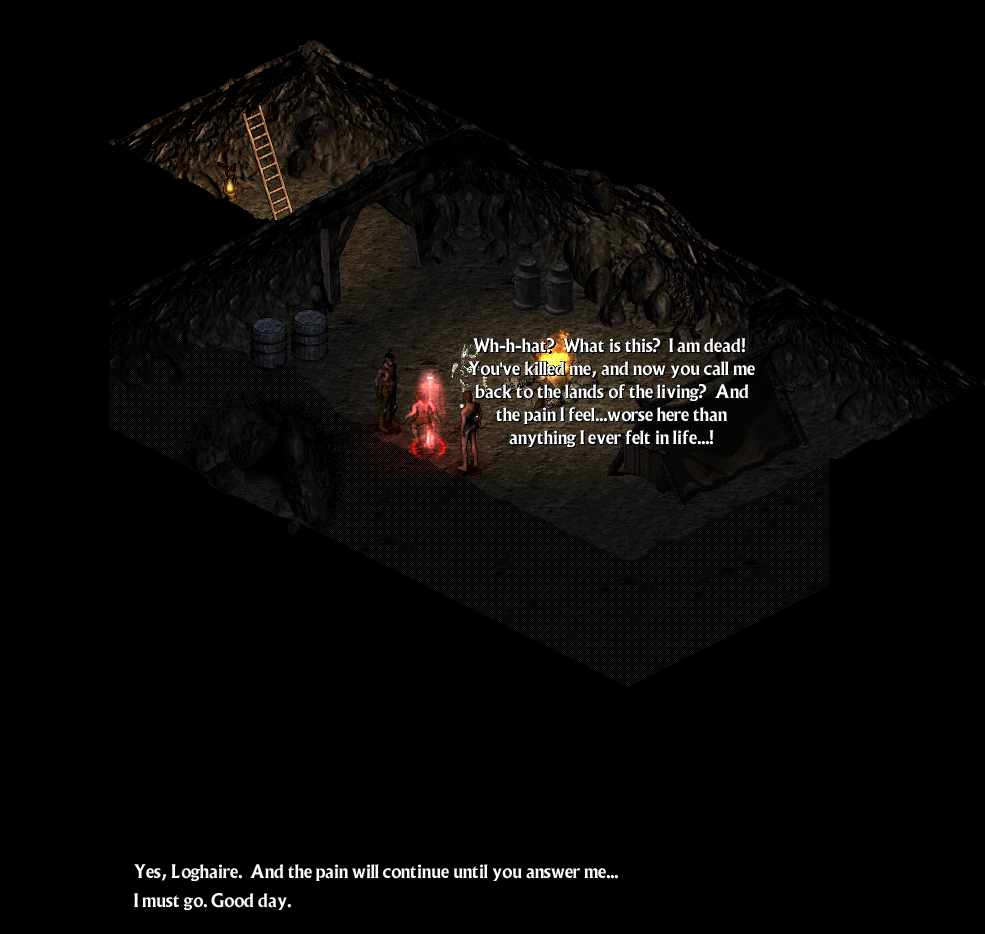
It is absolutely disconnected and thematically weak. What should have happened is, Arronax should have indeed been the antagonist, and he should try to convince you to join his side. After all, he wasn’t evil, just proactive and… maybe too trigger happy. Or maybe not, it should be up to the player to decide, perfectly fitting within the game’s immense role-playing and themes.
Join Arronax, who should have been revealed to have ordered the banishment of the Black Mountain Clan due to them letting steam technology fall into the hands of the humans who now want to take over everything with it. Or side with the industrial, technological revolution led by the Gnomish merchant guild that runs Tarant, with Gilbert Bates being the man to introduce you to them. So this would all have to be written in, the Gnomish merchants would have had to have been developed into characters and a faction of their own, and I guess Troika didn’t have time for it so worst case scenario is, use Gilbert Bates as their figurehead, basically informing the player that they’re not important enough to meet with the real ruling power of Tarant.
Or join Nasrudin and try to achieve a fragile balance (which should imply that it will never hold or be permanent). And who you side with should change the entire ending; siding with Arronax should literally result in war occupying Arcanum, and conquering Tarant being the ending. Siding with Nasrudin or Tarant should just involve assassinating Arronax while in the Void, and the game would end there as it does now.
As for Kerghan, they should’ve just made it so he’d be along with all the other legendary banished figures in the Void – you can try to recruit Kerghan and the rest to try and take down Arronax, and if you succeed, he should try to recruit you to his cause which can be the same as it is in the current game, and turn on you if you refuse. The consequence of thinking you can fight alongside the original necromancer for a greater good.
SPOILERS END HERE
Furthermore, unlike Bloodlines, not every quest in Arcanum (save for the last 1-2 hours given what we just stated) is brilliant; several side quests include excessively stupid, helpless NPCs, like a typical TV show or movie. Luckily these are few and far between, and at least the game makes them blatantly funny so it’s not as bad as having similarly crappy quests in a game that’s dead serious and relies on such weak design for more important quests (once again, I’m looking at modern day BioWare).
We have written about Arcanum’s writing before; it is an honorable mention in our Ten Best Stories in Video Game History article. Note what we’ve said about characters so far; Arcanum doesn’t try to write amazing characters, but generic NPCs around the world are actual distinct individuals often times, which is totally unlike open world games today. Its industrial revolution, tech vs magick, class based society, religious themes, and race themes and others are thoughtfully incorporated into most of its quests, and these quests almost always consist of actual distinct tasks rather than just killing things. It is a real RPG, very dialogue heavy and role-playing heavy as one would hope.
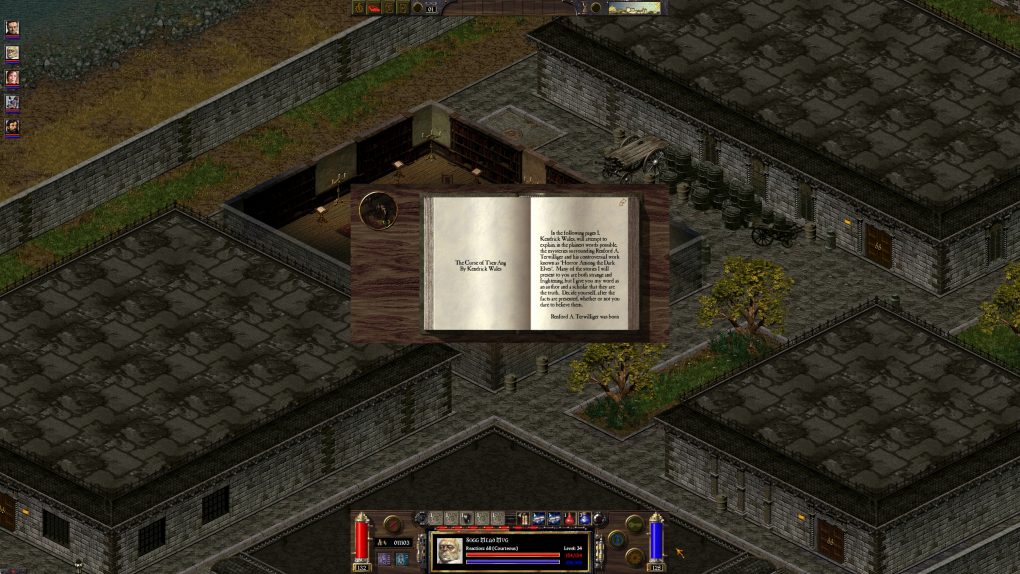
Reading this study of a short story that may reveal needed information to pursue a lead. After this, I went on to try and find a copy of the short story in question.
Some of its quests involve reading, something too many people today are afraid of. We make note of one particularly amazing quest that entails reading a well written short story and a nonfiction study of it pictured above. This is by far the most authentic Lovecraftian writing of any game, and you don’t just read Lovecraftian stories in this quest, but you get to play the part of a Lovecraft protagonist! As a huge fan of Lovecraft, this quest was particularly amazing to me, and typically I am insulted by video game attempts at capturing Lovecraft’s magic as they usually tarnish it.
Unique quests like this can be found all over the game world, opposed to the monotone repetitive generic quests of a modern day RPG, both mainstream and indie. The superior quality of Arcanum versus the RPGs of today in all of the most important elements (writing, role-playing, quest design, gameplay design and diversity) cannot be understated.
The world of Arcanum is ripe with attention to detail. From legible street signs and building numbers by necessity, as you will be exploring the game world the way you would actually explore the real world before GPS (so yes, the in-game map is not a GPS), to keeping up with the world via newspapers, to quest design that involves all of these things and carrying out investigations without having your hand held (talking to people, visiting public archives, no objective markers), it is a wonder how game design has mostly gone backwards from this, and it is so refreshing to be able to take on quests from all the possible angles this game lets you approach them, complete them in all the ways this game lets you complete them, all while performing mostly realistic, involving, and less repetitive tasks than just killing things.
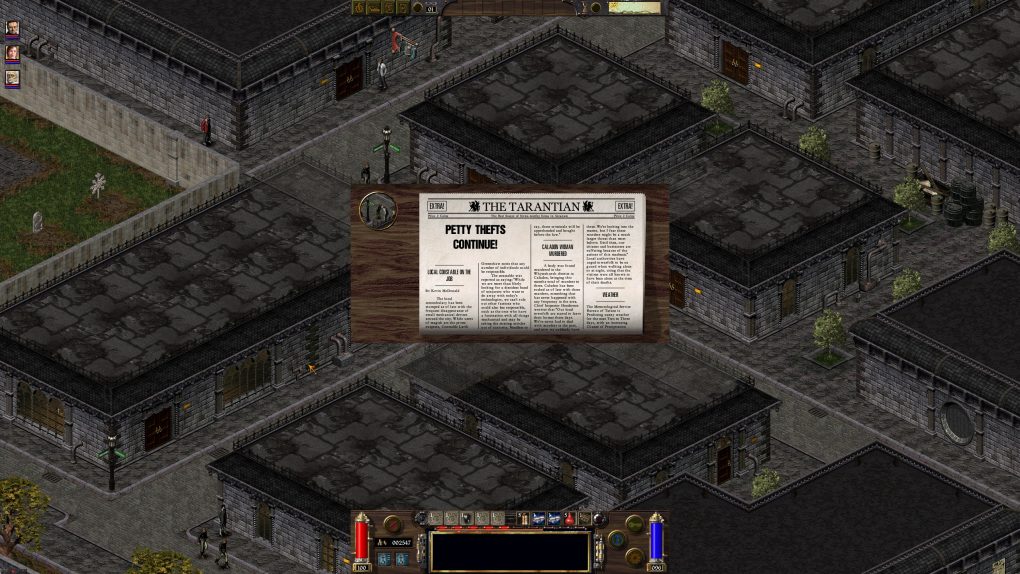
Reading newspapers to understand the world around you and possibly discover useful information that can aid with a quest, and the game never stoops so low as to ever tell you to read them.
How Modern Technology Would Improve It
This is a new feature I’m adding to reviews of old games, or backwards newer games using/mimicking old technology to target nostalgia over quality. PC gamers today are often extremely backwards minded and against innovation, hence modern game design typically reflecting this.
Although every favored classic game utilized technology to improve itself to the point of becoming a classic, this fact is lost on most PC gamers today. So it is necessary to analyze how a classic or modern technologically regressive game would benefit from the latest and greatest technology, since we have the technology today to overcome almost all game design limitations of the past.
Arcanum is an imitation 3D game (2.5D), released a few years before the 3D takeover. Troika’s final game would be their 3D debut. With modern technology, it could have the following improvements:
- 3D, highly detailed visuals with actual ceilings and skyboxes, thus also enabling things like physics based weather simulation which spells can manipulate
- No loading screens, no manual LODs
- Fully destructible world which both guns and spells could manipulate
- AI accelerated NPCs capable of speech and memory; useful for both inconsequential dialogue and AI generated side quest content, which would be helpful at filling out the world
- AI accelerated procedurally generated parts of the level to fill in the blanks
- Machine learning accelerated adaptable AI
- Fully path traced rendering would enable physically accurate lighting which would make the destruction work properly, add a new gameplay element (light) which can also affect spell design (e.g. light/darkness spells)
- Dynamic fire propagation to make fire-based spells exciting
- Elemental physics simulation so that fires can be put out, water frozen or melted, electricity physics (the Tesla Rod would benefit hugely from this), and more
Audio and Visuals
| 64-bit | No |
|---|---|
| Linux Support | No |
| Graphics API | DirectX 7 |
| Frame Rate | 30 FPS limit (requires unofficial patch for more) |
| High Resolution Support | Requires unofficial patch and windowed mode (Borderless Gaming is compatible) |
| Ultrawide Support | Requires unofficial patch |
| High Refresh Rate Support | Yes |
| VR | No |
| Display HDR | No |
| Ray Tracing | No |
| Multicore CPU Support | No |
| Adjustable FOV | No |
| Anisotropic Filtering | No (2D rendered game) |
| Anti-Aliasing | No |
| Upscaling | None |
| Sound API | DirectSound? |
| Sound | 2 channels |
| Dolby Atmos | No |
| UI Scaling | Requires unofficial patch |
| “Analog” Keyboard Support | No |
| Debug Console | No |
| Modding | Yes (SDK) |
Arcanum’s 2.5D engine, comprised mostly of 2D visuals, is actually worse than Infinity Engine which precedes it, but it is better than the engine that powers Fallout and Fallout 2. It also doesn’t support more than two sound channels (so stereo/2.1 is the most you’re going to get out of it). So while it was technologically outdated at launch (ironically), thankfully it is artistically adept. The diversity of its open world environment crushes most other open world games from all eras, both indoors and outdoors. The variety of structures, from human to elven to dwarven, diversity in vegetation, environmental diversity is usually better in 2D/2.5D games since it is easier and cheaper to accomplish and Arcanum puts it on full display. Every settlement is unique as well.
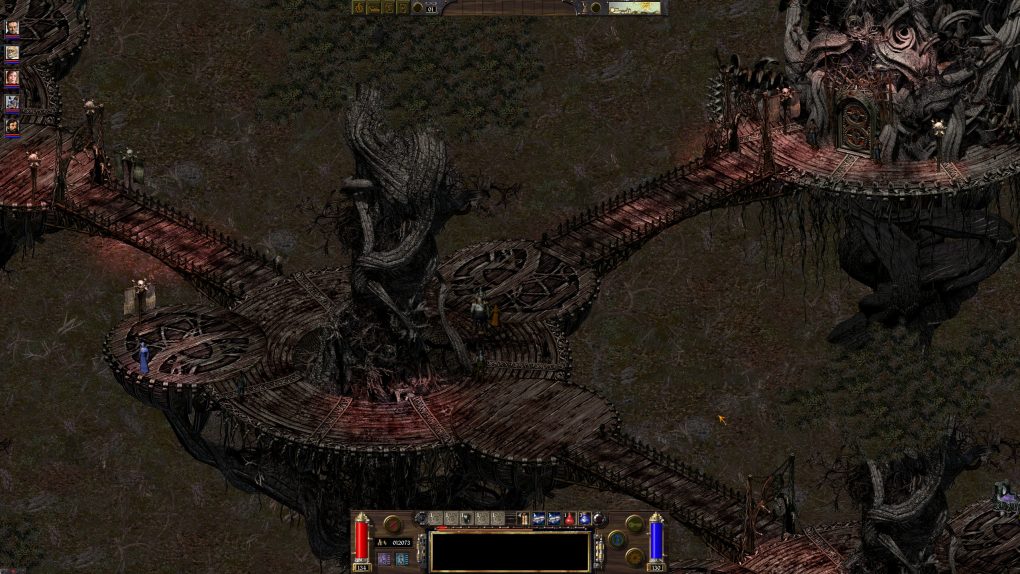 Dark Elves also live in trees, and seek to conquer and control nature opposed to coexisting with it like regular elves.
Dark Elves also live in trees, and seek to conquer and control nature opposed to coexisting with it like regular elves.Not many objects are 3D, only characters/creatures really. A dynamic day/night cycle is present.
Most dialogue is unvoiced, which allows for greater levels of role-playing and use of imagination, drawing on the power of literature which lets you use your imagination. But some dialogue is voiced; almost all of the dialogue from certain key characters is voiced, and the voice acting is very good and does not falter. The sound track of Arcanum is outstanding, mostly comprised of instruments from the time period and culture it is representing.
So while Arcanum was never strong technologically, to this day it remains eye catching due to its environmental diversity and unique environments. Steampunk games, especially RPGs, are few and far between.
By default, Arcanum runs at a capped 30 FPS like most other isometric 2.5D RPGs at the time, but it can be modified to run at a higher frame rate. I have tested it up to 120 FPS, and 120 FPS is a real treat, making the panning movements super smooth especially when used in tandem with 120 Hz ULMB, eliminating all perceivable motion blur. But I cannot run 120 FPS smoothly on my AMD Ryzen 7 1700X which returns massive stutter that was not present with my previous Intel Core i7 6700k. This follows the general trend of AMD Ryzen not running well in older games due to its CCX design.
Conclusion
Arcanum: Of Steamworks and Magick Obscura represents a higher class of RPG that is, as a matter of fact, absent from video gaming today. The amount of role-playing possible, which extends to the amount and responsiveness of dialogue present, the number of ways you can approach and complete quests, the amount of ways in which the world responds to various elements of your character build, the amount and variety of character builds available to the player, then other things such as the amount and variety of creatures and equipment/items present in the game world, Arcanum features several times more of all of this than almost all post-2010 RPGs, the only exceptions being number of weapons in Pillars of Eternity and number of spells in both Pillars of Eternity and Divinity: Original Sin series (but Pillars of Eternity lacks in quality in these areas). This not only shows how excellent Arcanum is, it shows how embarrassing modern RPGs are as the amount of effort put into them is substantially less.
The same notion applies to Arcanum’s writing; from an objective point of view it contains far more elements to its universe, lore and related exposition, thematic depth, and much higher quality dialogue than 99.9% of video games today. The writing is not just deeper, but wider as well, encompassing more themes and ideas than most, raising more questions and more possible discussion on themes such as industrial revolution, questioning our use and obsession with technology and the dangers it presents, class based societies, racism, religion, and more. The depth it provides into any one of these themes is greater than the entirety of the narrative depth present in the vast majority of games especially today, especially cinematic AAA Hollywood inspired games which abandon literary influence.
More intellectual material and more fun is what Arcanum has over most other RPGs, thanks to deeper writing, more role-playing, better gameplay balance, and more gameplay variety leading to more character builds, many times greater variety in enemy encounters, far greater diversity in spells and equipment, and also much more creative gameplay design resulting in more distinct and awesome spells, and some of the coolest technological gadgets (weapons, armor, and other items) you will ever see in a game.
Let’s try out our new scoring system. We are abandoning the use of a numerical scoring system, instead listing its strengths and weaknesses and then a final recommendation based not only on the strengths and weaknesses, but most of all whether or not the game was actually crafted with care and passion, or was it just designed not as a work of art but as a bare minimum product to profit as much as possible while taking advantage of an uneducated gullible consumer base?
Strengths
- Role-playing. It has more of it than all but one other single player video game RPG overall. This game responds more to your race choice than all but one other game, that one other game being Troika’s own Vampire: The Masquerade – Bloodlines. This is one of very few elite RPGs that can alter every single encounter/conversation based on your character build—Arcanum only does this based on your intelligence score, but of course other ability scores and factors will change the vast majority of dialogue throughout the game (mostly tech vs magick expertise, race, charisma, and reputation in addition to intelligence). And then the use of necromancy on the role-playing experience… awesome! Too bad it’s probably the only fantasy RPG to do this…
- Writing quality and depth. In terms of world building and the story, it is in the elite by video game standards, having far more themes and more depth, and a much more fleshed out and detailed world with better written and more logical lore and dialogue than 99.9% of games.
- The core rule/stat system. It is very logical and leads to excellent diversity in character build potential; 8 races + gender choice, 16 skills, 8 technological disciplines with 7 degrees in each (each degree unlocks a new recipe leading to a unique item), 16 spell colleges with 5 spells in each for a total of 80 spells with superior diversity, too many creatures and thus possible enemy encounters to count. Significantly greater in all of these aspects than the vast majority of RPGs.
- Quest design. Arcanum, Fallout, Fallout 2, and Planescape: Torment, are the very best RPGs in this regard. They consistently provide the most ways to approach and complete quests opposed to railroading you into two choices like most of today’s abysmal RPGs do, they are comprised of unique tasks very often, and quest availability will change depending on your character build, unlike most other RPGs. Quests and also shops will often be restricted to characters either pursuing technology or magick, not both, and both reputation and race can be a significant factor here as well.
- Creativity and diversity of equipment, from weapons to armor and other items. Arcanum embarrasses most other RPGs here, especially in creativity. The things you will craft if you pursue technology will blow your mind.
- Ability to play either in turn-based or real-time.
- Lasting appeal and replayability based on all of the above. All of the role-playing and character build choices mean the game can be totally different on many subsequent playthroughs. My playthrough was somewhere in the 100 hour ball park. Then there’s the multiplayer, which is co-op but lacks a game master.
- Enormous open world that is masterfully crafted from an artistic perspective. It is a unique setting with nothing like it in gaming. Obviously there’s a lot of space that only has dynamic encounters, but at least the real content is spread out nicely. The world is incredibly diverse; the human, elven, dark elf, and dwarf architectures emanate character. Cities and towns are some of the most distinct of any game, from the architecture to the wonderfully detailed interior decor. Awesome dungeons as well. Cities and towns have so much depth and detail that you’ll actually be navigating with street signs and reading address labels on buildings. This is one of the most content-rich and immersive games out there, it’s way more than 10x the game almost any modern RPG is.
- Despite the vast amount of skills and spells, the UI is expertly designed, presenting all of this information in such a streamlined, efficient manner. This is one of few older games with clever, timeless UI design, surpassing that of most “cRPGs” if it only had UI scaling.
- More lively AI than most RPGs today surprisingly. In villages, towns, and cities they go to sleep at night and lock their doors. Electric lamps in the more technologically advanced places will automatically turn on at night. NPCs move around, go in and out of buildings pretending to do things. This combined with the scale and depth of the game, the attention to detail in level design and unique setting, there’s just so much more to Arcanum than most RPGs, especially the watered down crap from today (including today’s “cRPGs”).
Weaknesses
- Requires unofficial patch which doesn’t even work with a 100% success rate. Chances are you’ll have to run this game in windowed instead of fullscreen, but it does at least work with Borderless Gaming. Still, it desperately needs a remaster, to fix the existing widescreen issues and add UI scaling.
- The distant isometric 2.5D visuals have issues; it is possible for some rooms, NPCs (including hostiles in combat), or objects to be obscured due to improper translucency of preceding tiles. So this means sometimes you won’t be able to target hostile NPCs in combat from certain positions.
- The conclusion of the story, the final mission. It was rushed and as a result is a disconnected, weak and bizarre conclusion, unforeseen and too unrelated to the themes that Arcanum wonderfully explores throughout.
- Some unresolved bugs such as the permanent stun bug which will happen in turn-based or fast turn-based mode if an opponent stuns you and then that opponent gets killed (you can fix it by changing combat mode to real time).
- Some issues with spell balancing. Black Necromantic and Mind affecting spells affect nonliving creatures, but they shouldn’t. Also the Harm spell is overpowered and way too much of a universal utility that works on everything.
- Some oversights in the programming of certain spells causing potentially unintended behavior.
- Wasted space in its vast open world environment, but thankfully fast travel is present.
- AI is weak when it comes to combat tactics. They’re also unable to use doors, so turn-based combat around doors becomes clunky.
- Summoned AI won’t attack hostile enemies that have yet to engage the player in combat. For example, if your party gets into a hostile encounter, but all hostiles only attack your companions and not you, then your summoned AI won’t bother attacking the hostiles.
- It is annoying how in some regions, when fast traveling you may get interrupted and attacked every few seconds. I get that some parts of the world are more dangerous, but it’s just really obnoxious to be stopped 6 times in just a few seconds of fast traveling, barely actually getting any traveling done (and I’m not exaggerating).
- Could use more NPCs in towns and cities.
- A very small amount of side quests, while designed to be funny, still make characters unbelievably stupid, so these few quests end up forgettable. Thankfully these quests are rare, while quests of this caliber make up at least 90% of modern RPG quests (and this is not limited to modern AAA RPGs).
- Without spoiling anything, why doesn’t the gnome in the intro cutscene give you the name of “the boy?”
- Needs horses and carriages, especially with Tarant having cobblestone roads with sidewalks
- Never understood why castles are so artificially scaled down; it’s a 2D game so they can easily be and should be closer to life sized
Arcanum: Of Steamworks and Magick Obscura was very clearly designed to be a groundbreaking RPG, one of the largest in scale yet richest in writing and gameplay, trying to maintain the highest tier of role-playing while adding never before seen levels of gameplay content and diversity opposed to being limited to typical fantasy, making it one of the most ambitious games ever designed. No game was made with more passion than Arcanum, and this level of passion is nearly extinct from modern AAA game development. Overall, Arcanum amounts to an enthralling experience that is infinitely richer than any RPG from the modern era.


